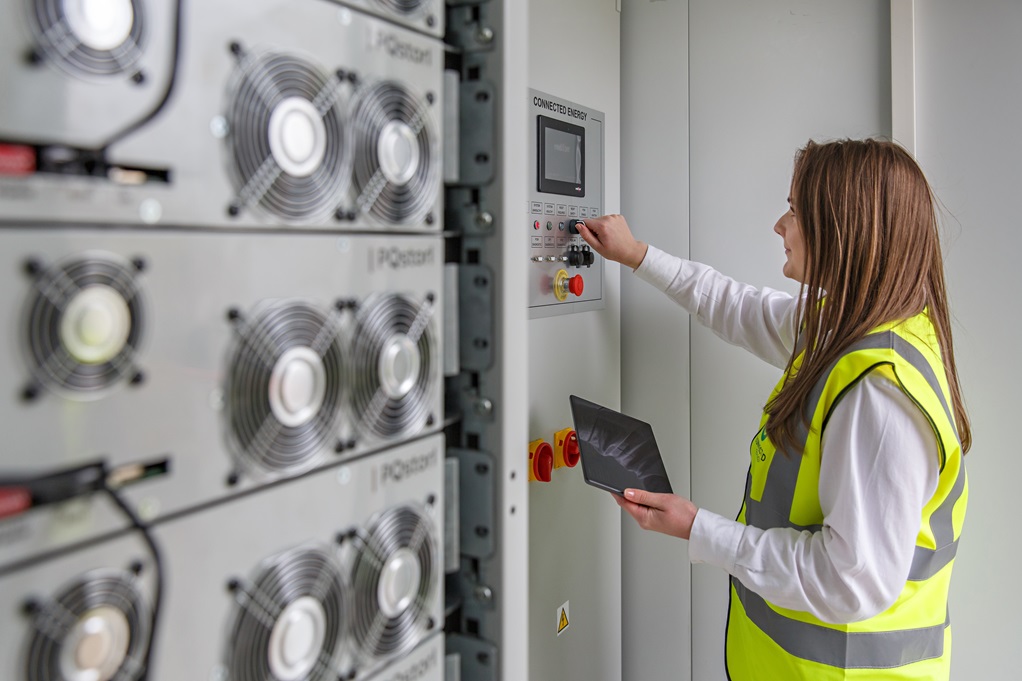Ports are planning major electrification projects ranging from ship-to-shore power to transitioning to electric vehicles and materials handling equipment (MHE). However, British Ports Association (BPA) research suggests that 70% of UK ports are already at or near to their ceiling in terms of available power from the grid. Other ports around the world are reporting similar issues.
“In many cases if ports want to meet their decarbonisation targets, they will need to upgrade their grid connections or find more cost-effective and flexible alternatives,” said Matthew Lumsden, CEO of Connected Energy. “This is why port operators are talking to us about how battery energy storage systems can solve some of their challenges around Net Zero.”
Connected Energy’s E-STOR system is already working across Europe to alleviate grid constraint issues for buildings and electric vehicle (EV) charging hubs. The BESS act as energy reservoirs, drawing down and storing power during quiet periods, then providing it as needed. This helps to flatten demand curves, reduce energy bills, and can even optimise on-site renewable energy generation.
“Ship-to-shore capability can require 5MW of power, which is a huge spike,” added Matthew. “Ports that rely on energy-intensive pumps face a similar issue. BESS can help meet that demand without putting extra strain on the grid.
“When it comes to fleet electrification, the size and scale of the charging infrastructure required takes some operators by surprise. We’ve heard from ports that were looking at up to 6MW of additional energy to power their electric truck fleet.”
In addition, all commercial sites have a limit on how much power they can consume, known as a maximum import capacity (MIC). Adding EV charging can push ports over their MIC, leading to expensive surcharges. “BESS are increasingly used in other sectors to prevent MIC breaches and make equal sense for ports and harbours,” said Matthew.
Based on real-world data from operational systems, Connected Energy calculates that a single 300kW E-STOR system can store 100MWh of electricity, which equates to saving 18 tonnes of carbon emissions each year. In addition, Connected Energy sources its batteries from end-of-life EVs, giving them a useful second life. This further reduces Scope 3 emissions, as each E-STOR provides a positive carbon benefit of 150 tonnes of CO2e compared with a BESS using brand new batteries. These metrics make energy storage a valuable asset for ports seeking the best possible decarbonisation benefits.
Two other common uses for BESS are helping to make the most of on-site solar arrays and generating revenue by selling energy back to the grid. “Solar capture is vital if ports want to increase their use of renewables and cut carbon emissions from energy consumption,” added Matthew. “For example, operators can store surplus solar energy in the BESS during the day and use it to power their fleets and facilities at night.
“There are also significant revenue opportunities, particularly over winter time, by using a BESS to participate in grid balancing services such as the UK’s new Demand Flexibility Services initiative which enables companies to be paid for agreeing to reduce the electricity they take from the grid at particular times of high demand.”
Source: Connected Energy.




Recent Posts
Pan Ocean Orders Two Eco-Ready VLCCs from HD Hyundai Heavy Industries
FincoEnergies Advances Digital Marine Biofuel Delivery with eBDN Technology Adoption
Ocean Hyway Cluster Secures Funding for Green Maritime Energy Station Pre-Study
Eitzen Group to Build 850 TEU Battery-Powered Containerships with Enova Backing
MSC Marks Hamburg Partnership with Festival and LNG Vessel Launch
Ocean Network Express Expands Fleet with Delivery of Newbuild ‘ONE Singapore’
GCMD Publishes Insights from Landmark Ammonia Transfer Trial Off Western Australia
GEODIS Releases 2024 Activity and Sustainability Report, Reaffirms Climate Commitment